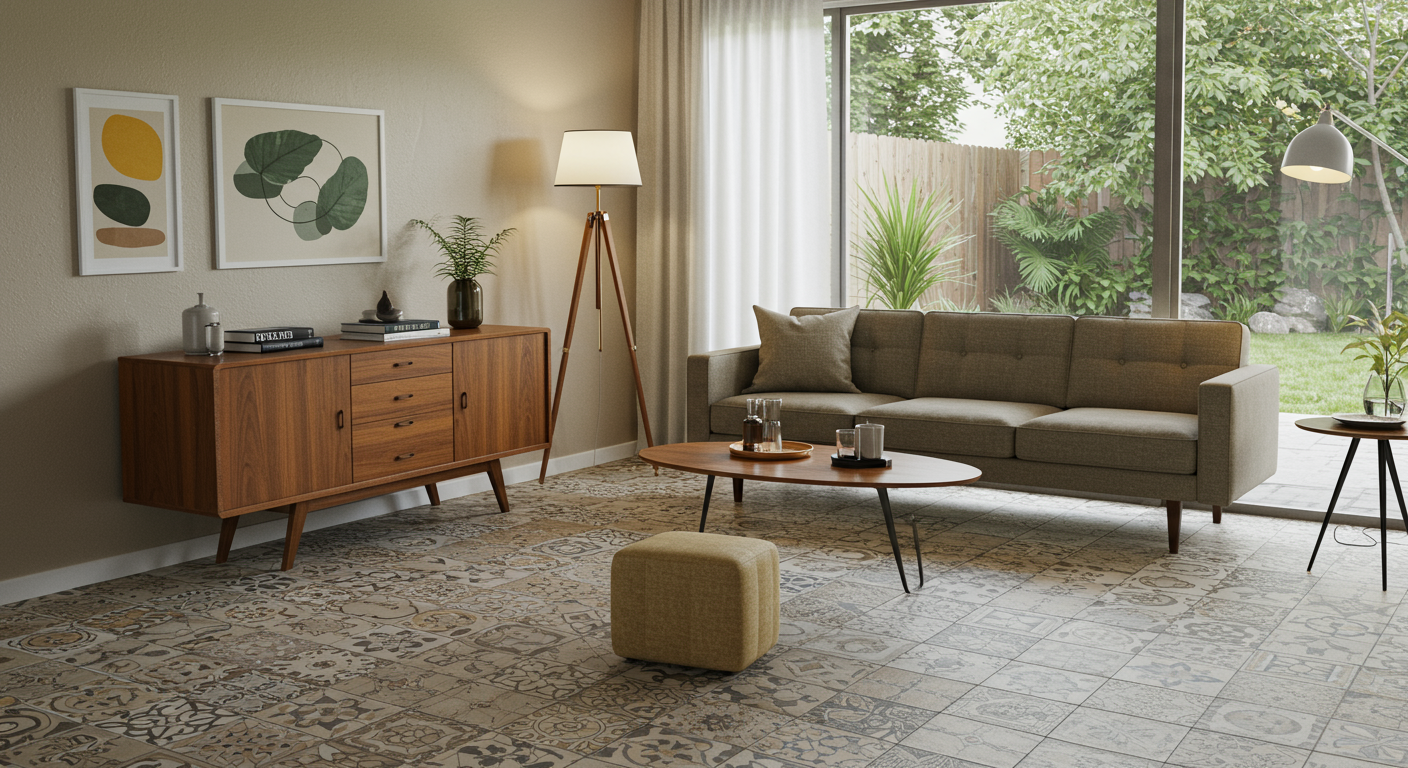Mid-Century Modern Flooring: A Guide to Classic Looks and DIY Solutions
The Complete Guide to Mid-Century Modern Flooring: From Classic Looks to DIY Solutions
Step into a classic mid-century modern living room. You see it, don’t you? The clean lines of a walnut sideboard, a sofa with tailored upholstery and tapered legs, and a big window blurring the line between indoors and out. It’s a style defined by an uncluttered, optimistic, and deeply human feel, and it’s no wonder it’s having such a massive resurgence. But as you build this look in your own home, you eventually look down and hit a roadblock: the floor. The foundation of any room, flooring can feel like an expensive, permanent, and daunting decision.
Don’t panic. You’ve just found your definitive guide. We’re going to demystify what mid-century modern flooring truly is, from its innovative historical roots to the incredible budget-friendly options available today. Forget the gatekeepers who say it has to cost a fortune. We’ll show you how to get that iconic look, and we’ll even review three fantastic DIY-friendly peel-and-stick tiles that can transform your space for less than you think.
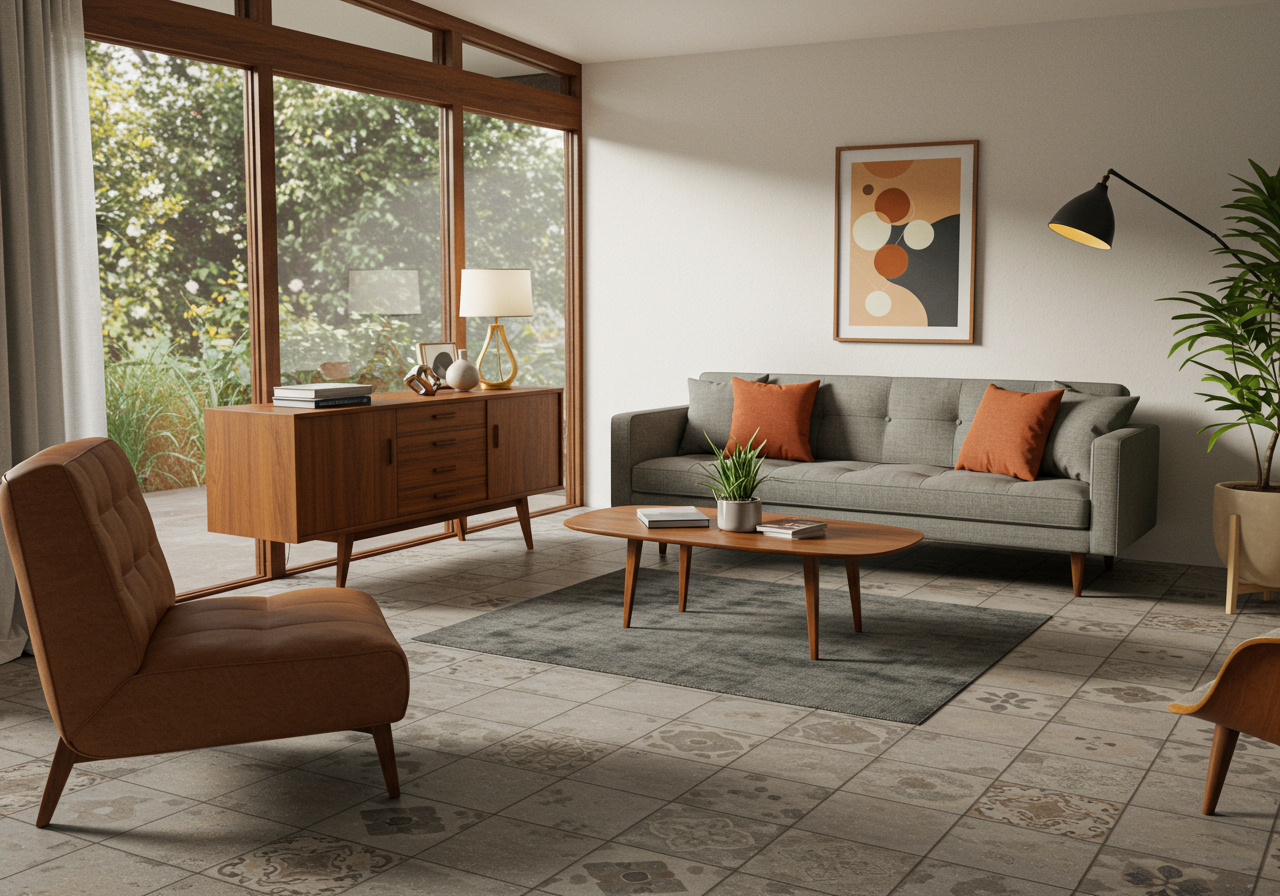
Decoding the Mid-Century Modern Floor
So, what exactly is mid-century modern (MCM) flooring? It’s far more than just “retro” patterns. Like the furniture and architecture of the era (roughly 1945-1969), the flooring was guided by a clear set of principles. Understanding this ethos is the key to choosing the right foundation for your room.
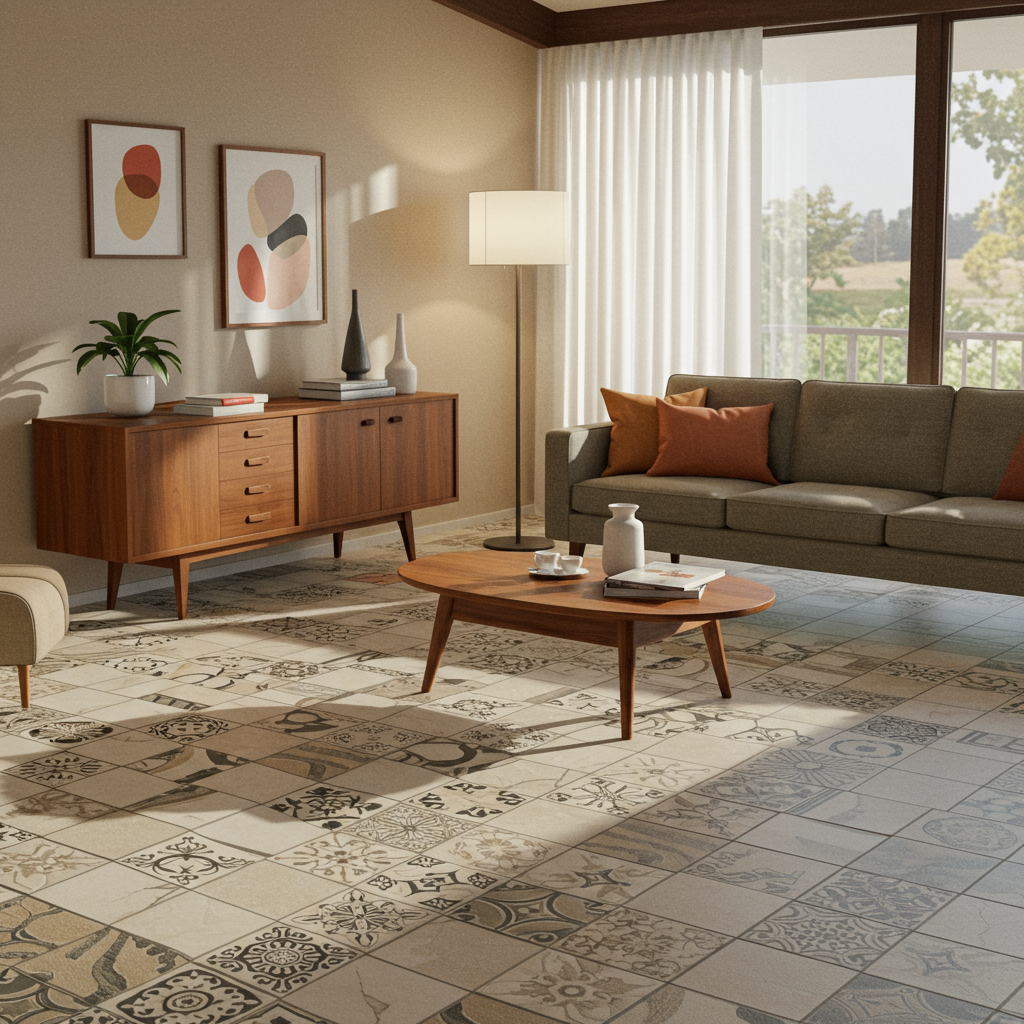
- Simplicity and Clean Lines: This style is the antithesis of fussy. Think materials laid in simple, straight patterns with minimal grout lines. The floor was meant to be a clean, cohesive plane that allowed the furniture and decor to shine, not a busy pattern that competed for attention.
- Organic and Geometric Forms: MCM designers loved the interplay between the natural and the man-made. This translated to floors that either felt organic and warm (like wood and cork) or embraced bold, playful geometric patterns that celebrated new manufacturing technologies.
- Honesty of Materials: A core tenet of modernism is celebrating a material for what it is. Wood looked like wood. Linoleum wasn’t trying to be stone; it was proud to be colorful, resilient linoleum. This honesty gave interiors an authentic, grounded feel.
- Functionality First: For the post-war family, life was busy. Floors needed to be durable, easy to clean, and relatively affordable. This focus on practicality was a driving force behind the material innovations of the time.
Ultimately, achieving an MCM look isn’t about finding one specific material. It’s about choosing a floor that embodies this spirit of clean, functional, and honest design.
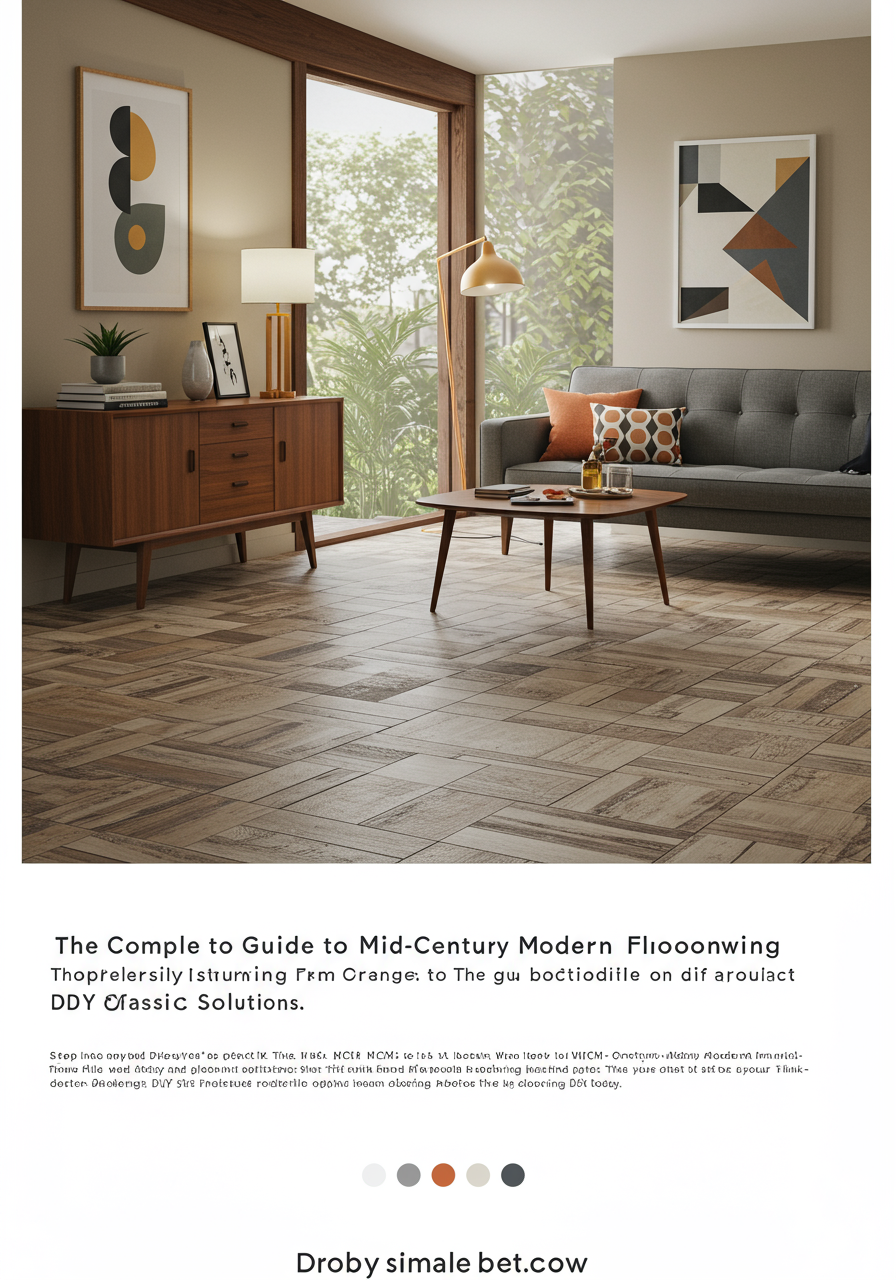
A Step Back in Time: The Floors of a Post-War World
To truly get MCM style, you have to understand the story behind it. The end of World War II unleashed a wave of optimism and a massive housing boom. Families flocked to the suburbs, and architects and designers were tasked with building a new American dream—quickly and affordably. This demand for new homes fueled incredible innovation in home-building materials, especially flooring. The floors of this era weren’t just decorative; they were symbols of progress.
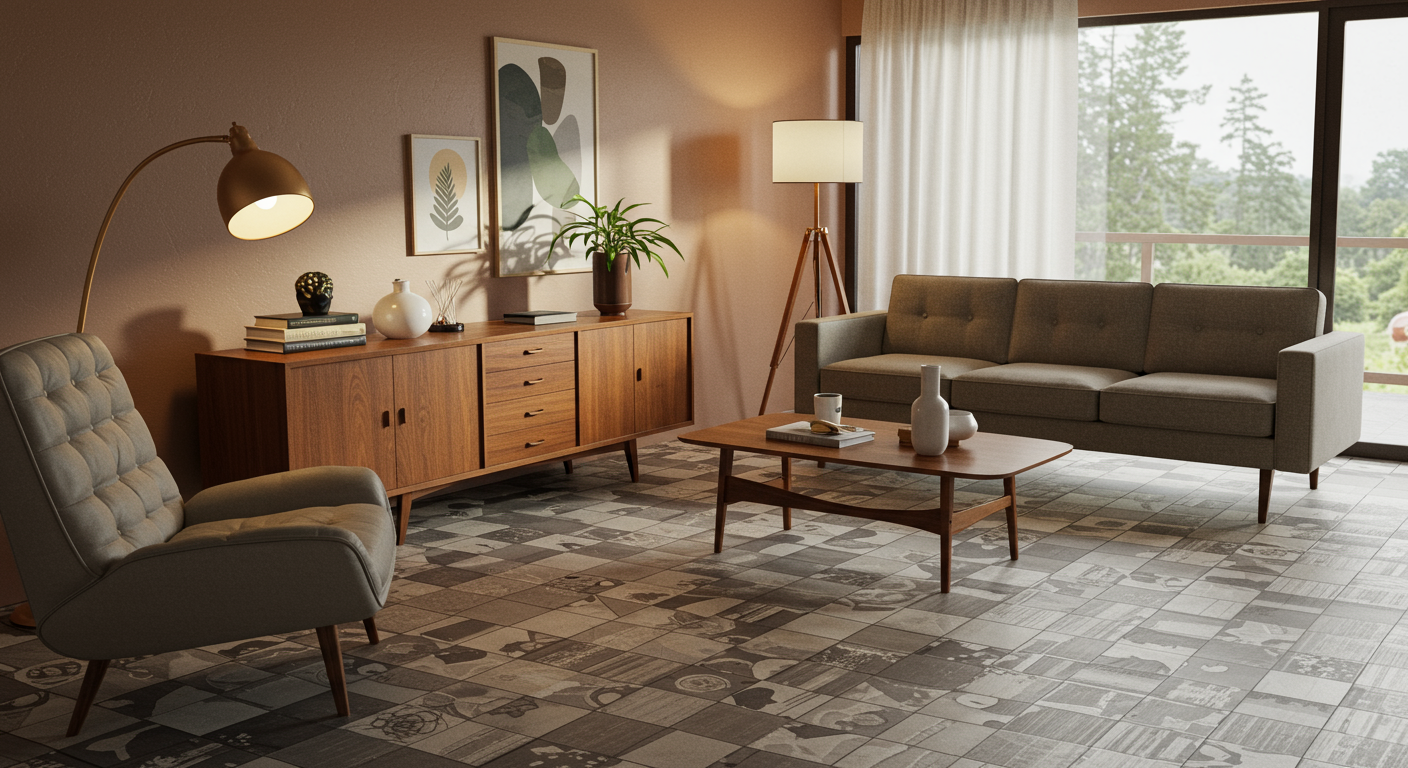
Here are the authentic materials that defined the mid-century home:
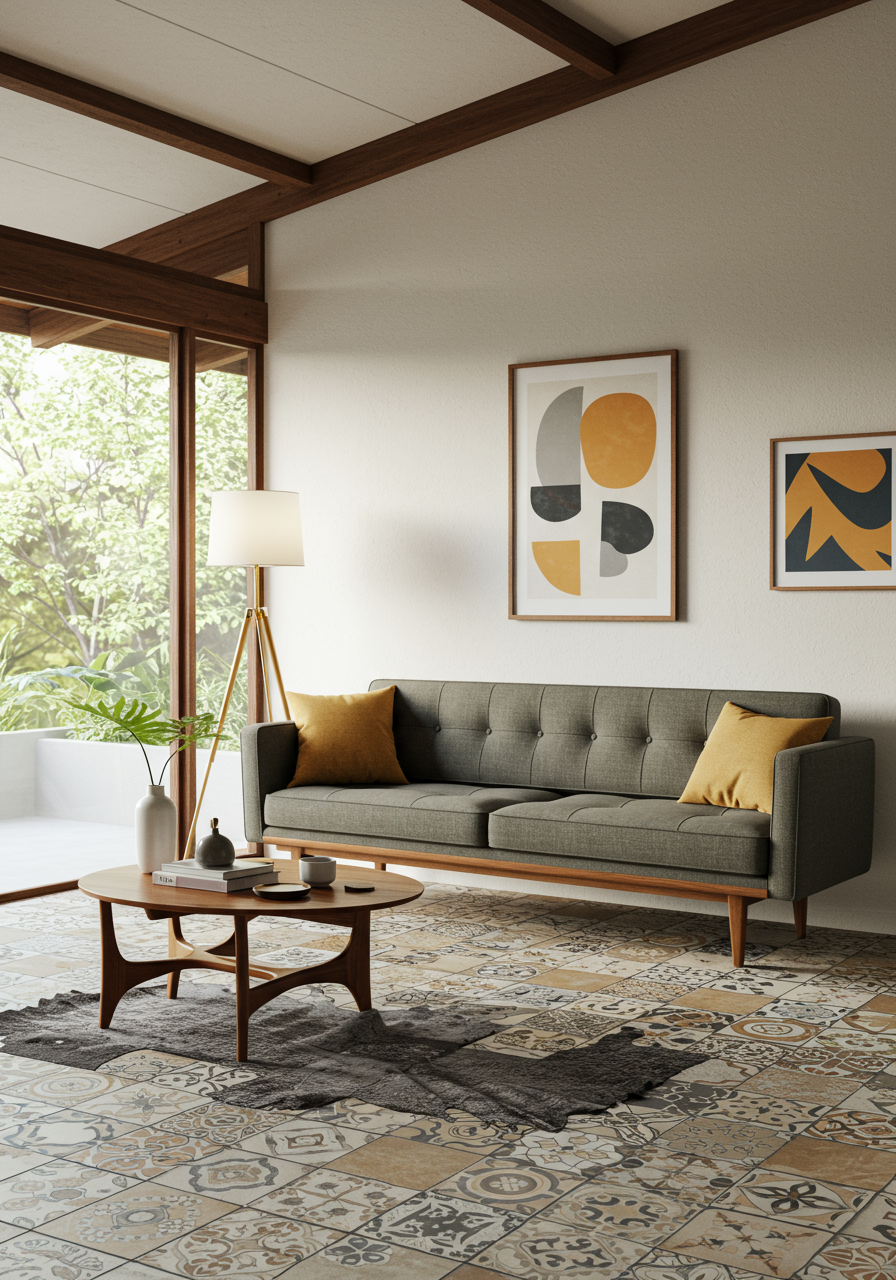
- Linoleum & VCT (Vinyl Composition Tile): These were the undisputed champions of the mid-century kitchen, basement, and bathroom. As a designer’s dream, they came in a rainbow of colors—from optimistic seafoam greens and sunny yellows to dramatic blacks and whites. They were cheap, incredibly durable, and easy to maintain, making them the perfect choice for the modern family.
- Hardwood: Wood never goes out of style, but the MCM era treated it differently. Gone were the intricate, ornate parquet patterns of the Victorian era. Mid-century homes featured simple, straight-laid planks of warm woods like oak and walnut. The goal was to create a clean, natural, and unassuming canvas.
- Cork: Prized for its incredible warmth underfoot, natural acoustic-dampening properties, and sustainable origins, cork was a popular choice for dens, home offices, and bedrooms. It had an organic texture that connected the home to the natural world.
- Terrazzo: If VCT was the everyman’s floor, terrazzo was its high-end, aspirational cousin. Made from chips of marble, quartz, granite, or glass set in a binder, it was poured in place and polished to a smooth, seamless finish. Common in custom-built homes, public buildings, and the sunny patios of Palm Springs, terrazzo embodied a sleek, permanent, and luxurious modernism.
These original materials are the DNA of MCM flooring, and their colors, textures, and patterns continue to inspire the best designs of today.
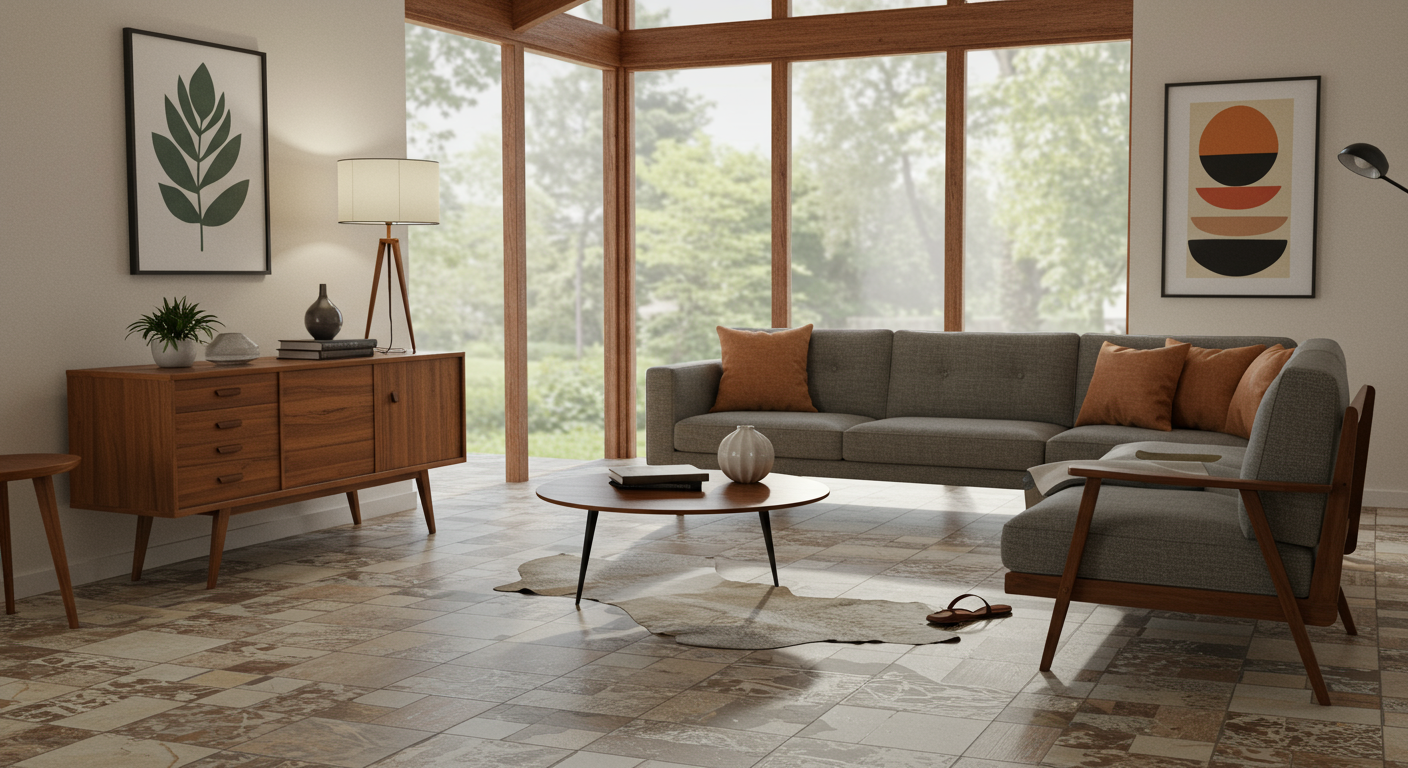
The Great Flooring Debate: Authenticity vs. Modern Convenience
Here’s where we get to the heart of the matter for today’s homeowner. In one corner, you have the purists. In the other, the pragmatists. Choosing your camp will define your project’s budget, timeline, and stress level.
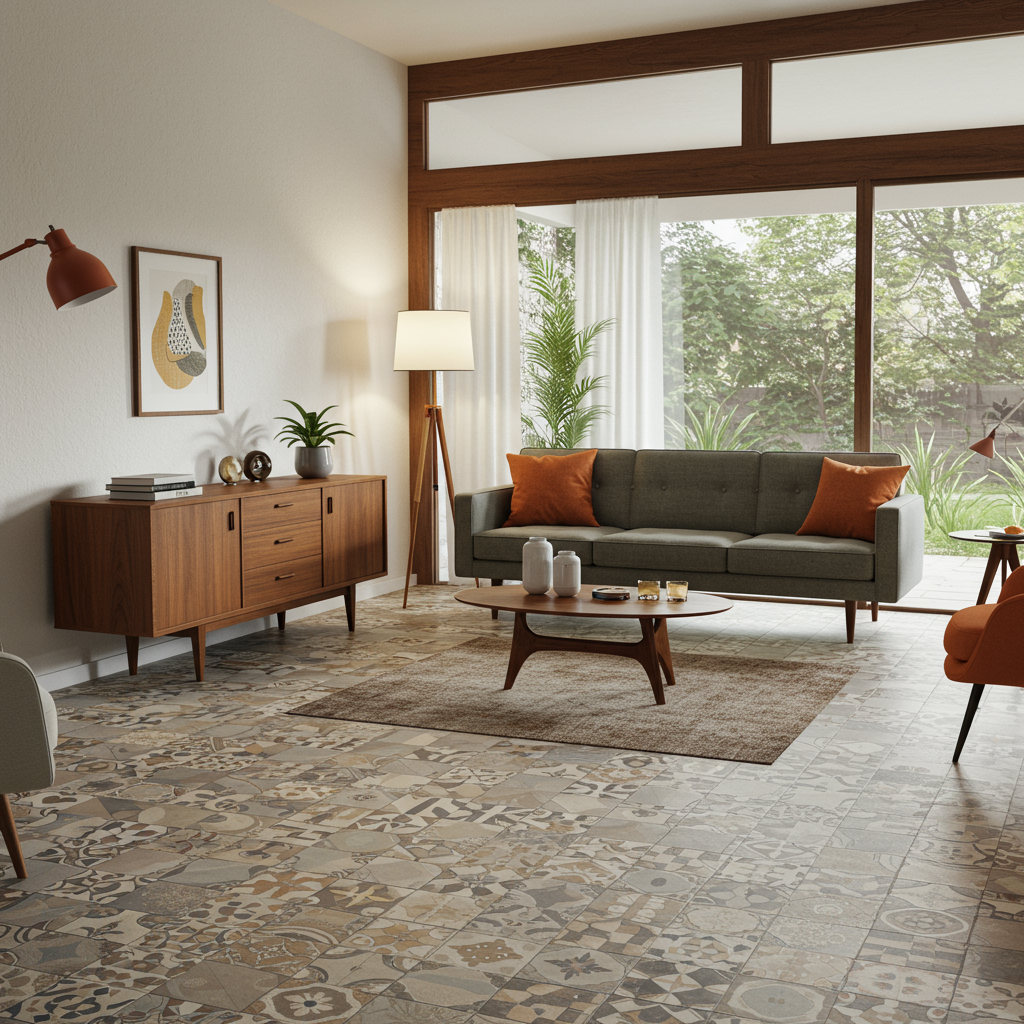
Camp “Purist”: The Argument for Authenticity
The purist believes that the only way to get a true mid-century modern floor is to use authentic or historically accurate materials. This means sourcing reclaimed hardwood, installing real cork tiles, or opting for Marmoleum (the modern, all-natural descendant of classic linoleum).
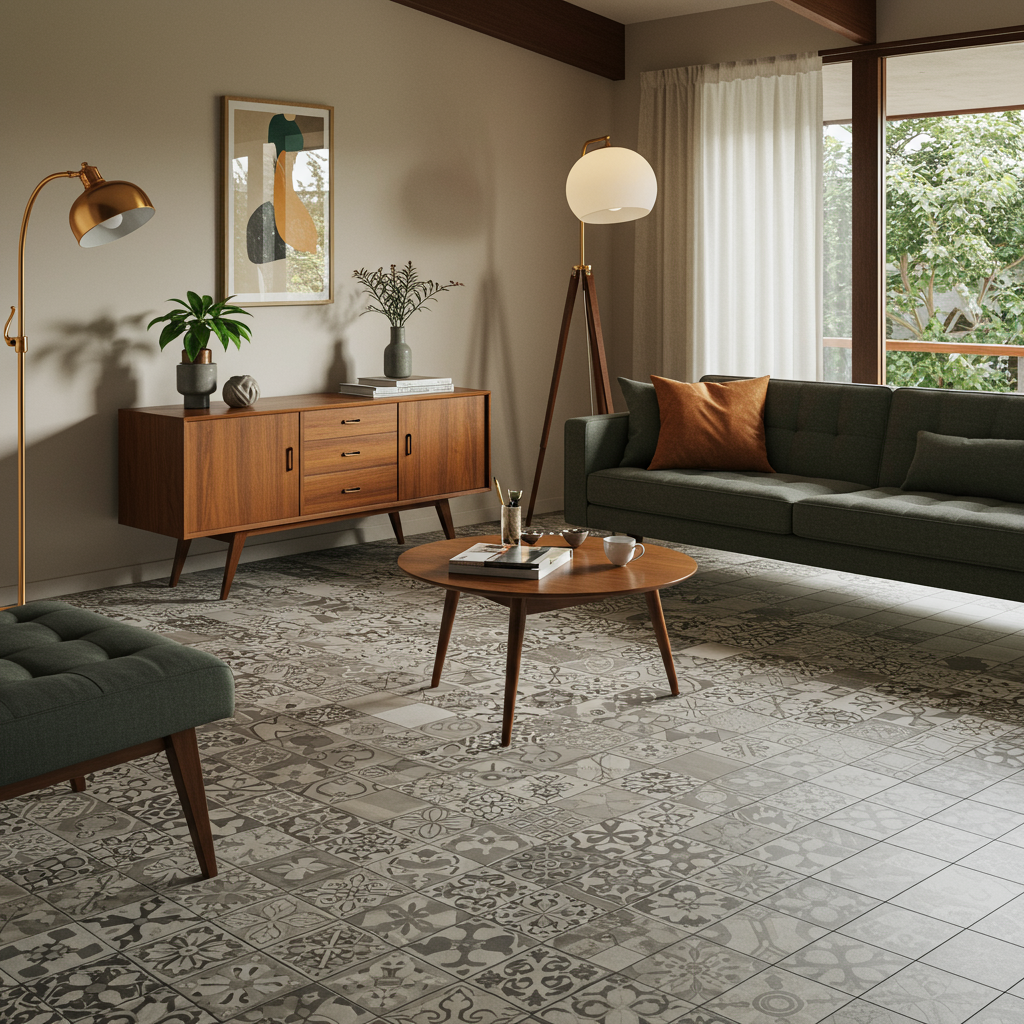
- Pros: This route delivers unmatched character, texture, and historical accuracy. These materials age beautifully and can significantly increase your home’s value. There’s an undeniable soul to a floor made of real wood or cork that a replica can’t quite capture.
- Cons: The drawbacks are significant. The cost is extremely high, often 5 to 10 times that of modern alternatives. Installation is a job for seasoned professionals, not a weekend DIY project. Finally, many of these materials, like hardwood and cork, require careful maintenance and are susceptible to water damage.
Camp “Pragmatist”: The Argument for the Modern Replica
The pragmatist loves the MCM aesthetic but has a real-world budget and a busy life. This camp argues that modern technology—specifically luxury vinyl tile (LVT) and its DIY-friendly cousin, peel-and-stick—allows us to capture the spirit and look of the era without the cost and hassle.
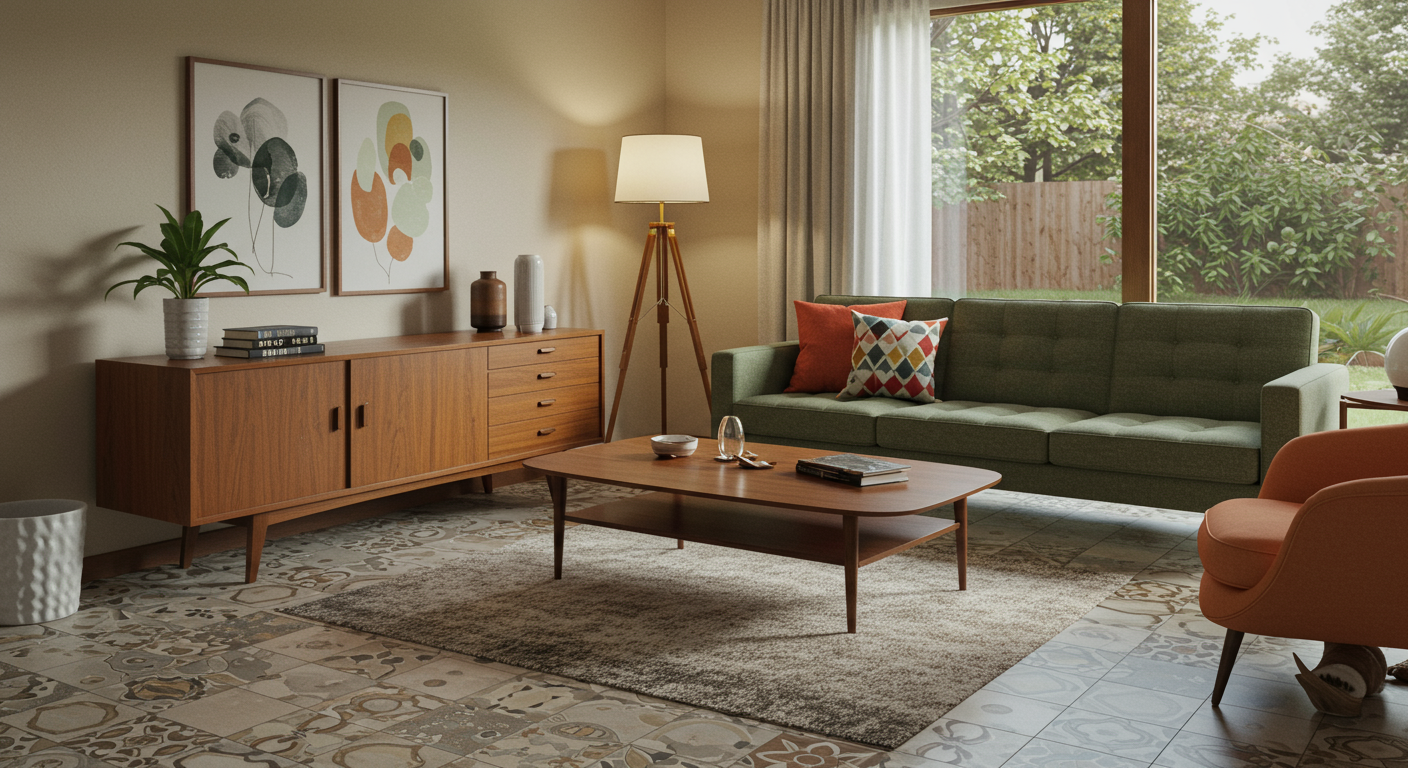
- Pros: The benefits are huge. It’s incredibly affordable, with options for every budget. It’s designed for do-it-yourself installation, saving you thousands in labor costs. The selection of patterns is virtually limitless, from realistic wood looks to bold geometrics. Best of all, it’s water-resistant and fantastically durable for homes with kids and pets.
- Cons: The main downside is a perceived lack of authenticity. While high-end LVT can be stunningly realistic, cheaper options can sometimes look the part. There are also questions about long-term durability compared to a 50-year hardwood or terrazzo floor, though many modern vinyls offer impressive 10-20 year warranties.
For the vast majority of us who want to bring that Mad Men vibe home without taking out a second mortgage, the pragmatist path is the clear winner. And that brings us to the DIYer’s secret weapon.
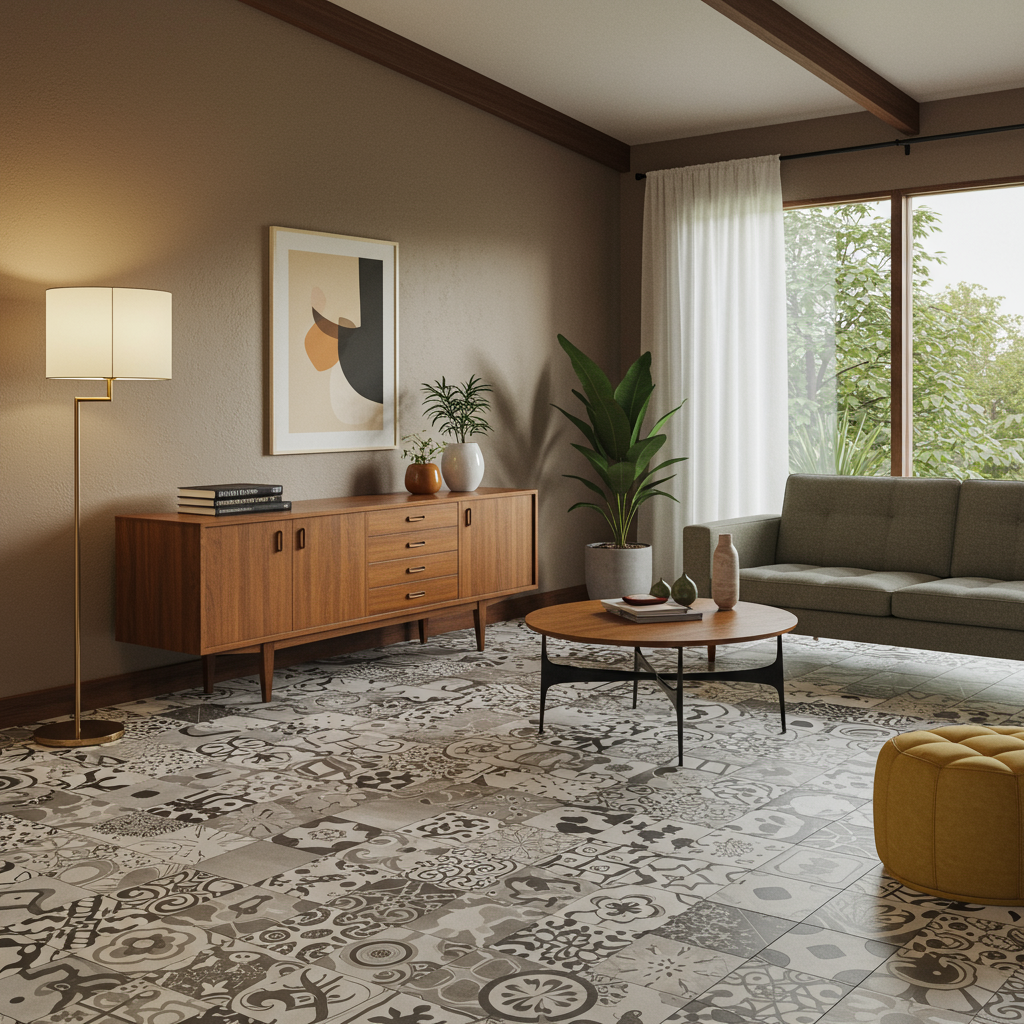
Your DIY Mid-Century Makeover: Top Peel-and-Stick Picks
Peel-and-stick vinyl tile has come a long way. Forget the flimsy, cheap-looking tiles of the past. Today’s products are thicker, more durable, and feature sophisticated, beautifully printed designs. They are the single fastest and most affordable way to achieve a dramatic mid-century modern transformation. Here are three of our top picks that nail the MCM aesthetic.
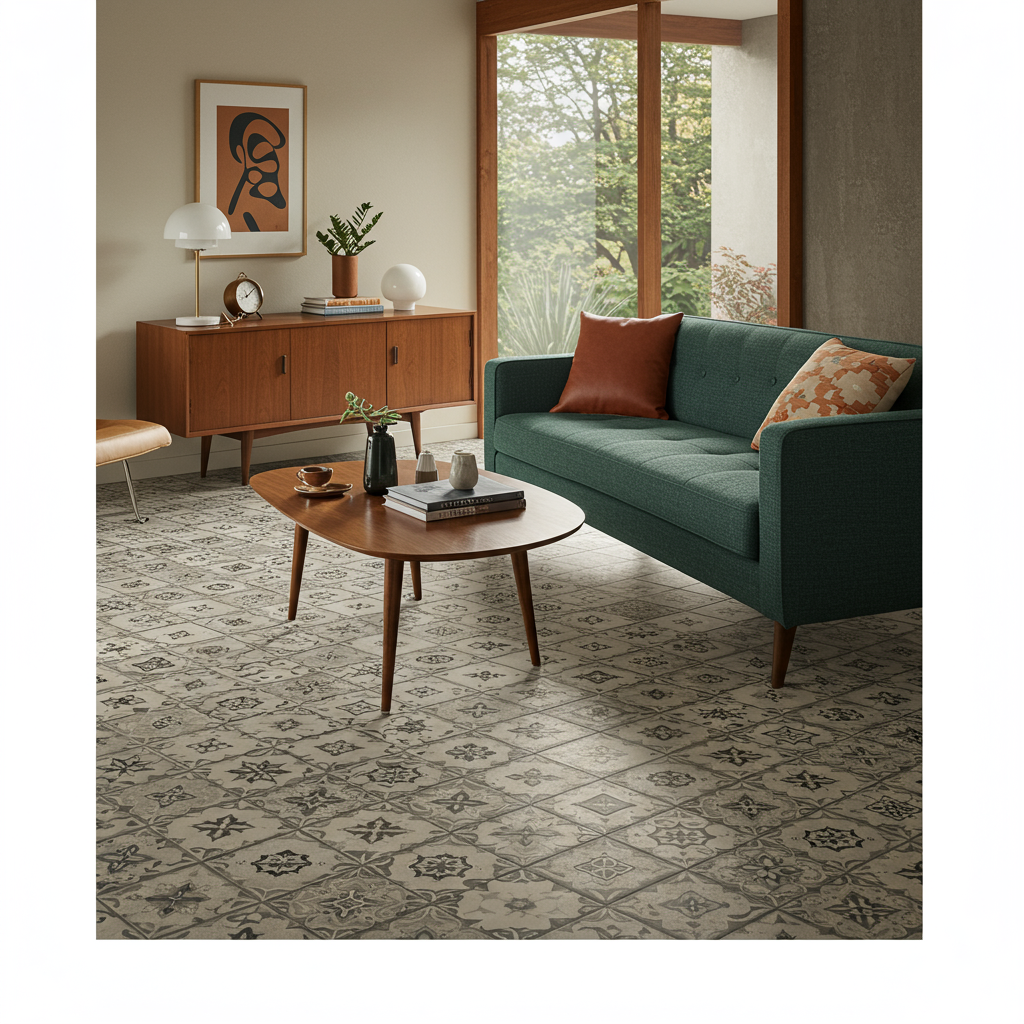
Review 1: The Modern Terrazzo/Slate — Nexus Self Adhesive Tiles, Mosaic Slate
The Look: This tile channels the high-end, organic feel of a classic terrazzo or slate floor but in a completely modern and accessible way. The Nexus Self Adhesive Tiles in Mosaic Slate pattern has a subtle, earthy texture with flecks of neutral color that won’t overwhelm a space. It’s the perfect, quiet foundation that lets your Eames-style chair and sculptural arc lamp be the stars of the show. It reads less like a direct copy and more like a modern interpretation of that natural stone look.
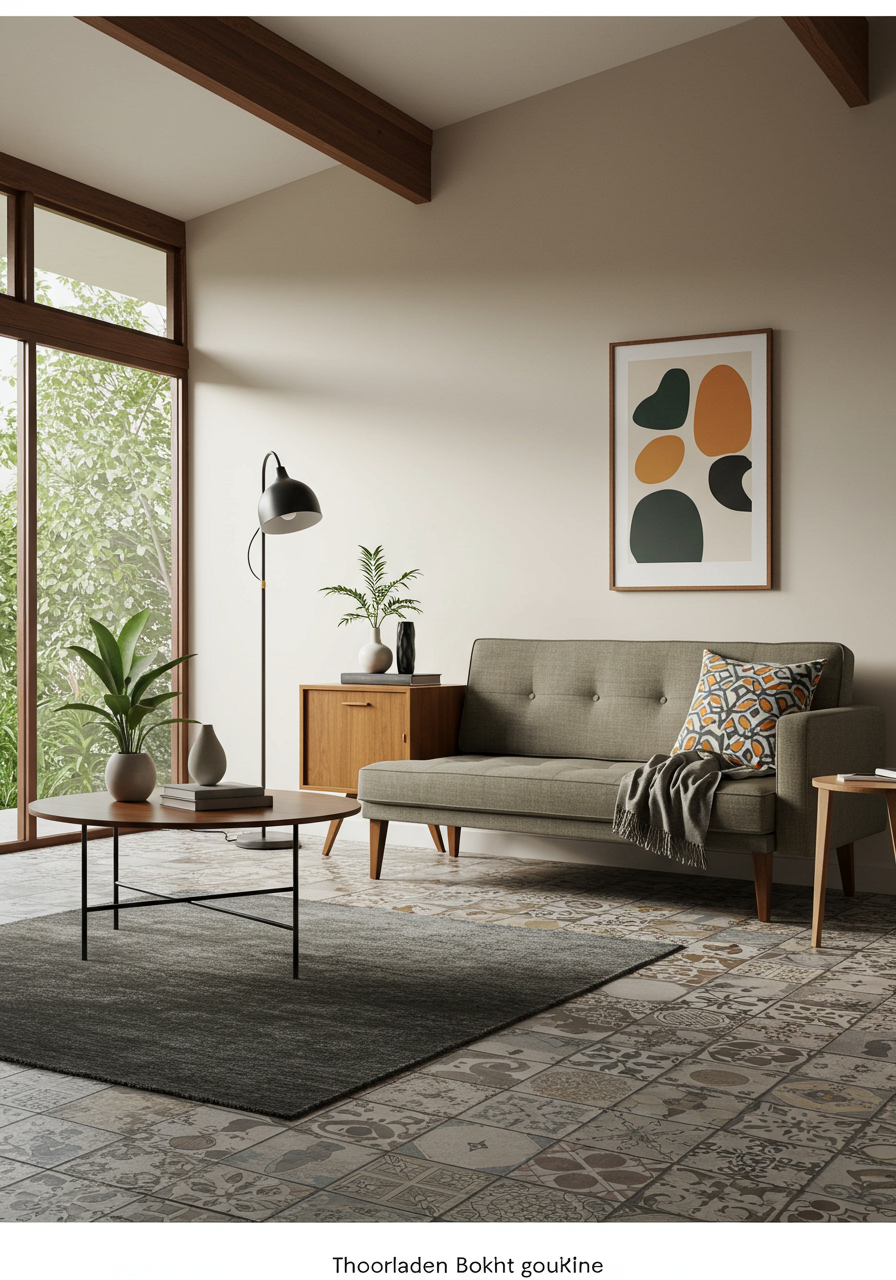
Best For: Kitchens, entryways, or bathrooms. Any space where you want a durable, stone-like floor that feels both organic and clean. Its neutral palette makes it incredibly versatile.
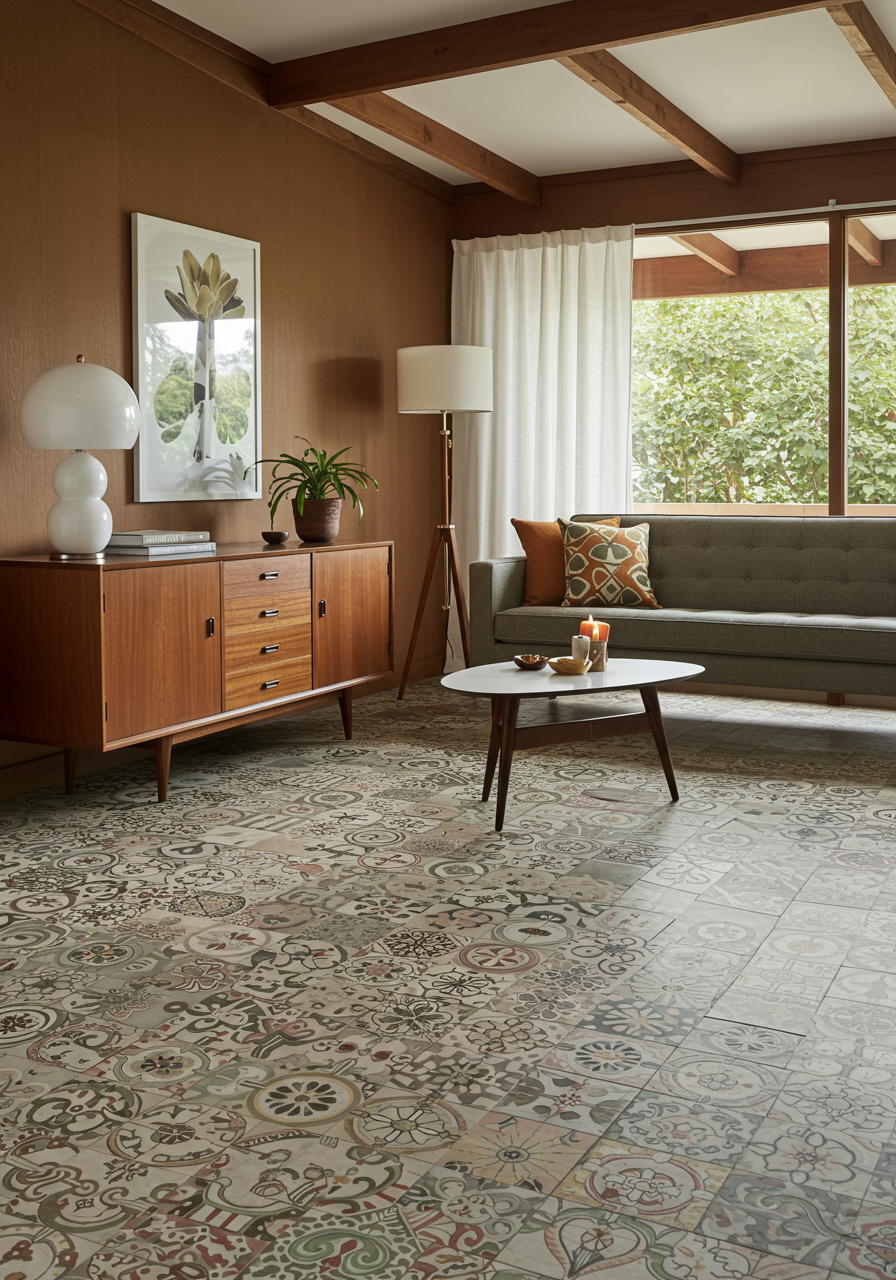
- Pros: The biggest pro is the incredible value; you simply cannot beat the price for the style. Users note how easy they are to cut and install, with one 77-year-old reviewer proudly stating she did a whole floor by herself. They have a nice, subtle sheen that looks clean and fresh.
- Cons: Because they are thin and flexible, surface prep is non-negotiable. As one person found, “you have to make sure you are putting them on a flat surface or you will be able to see any cracks/divots/nails underneath.” On very high-traffic floors, some have experienced sliding or buckling over several years.
Review 2: The Bold Geometric — FloorPops Black Biscotto Tiles
The Look: If your taste leans toward the playful, graphic side of MCM, this is your tile. The FloorPops Black Biscotto Peel & Stick Tiles feature a high-contrast, black-and-white geometric floral pattern that is a direct nod to the optimistic, decorative designs of the 60s. It’s a statement-maker that injects instant personality and a “simple slightly retro vibe” into a room.
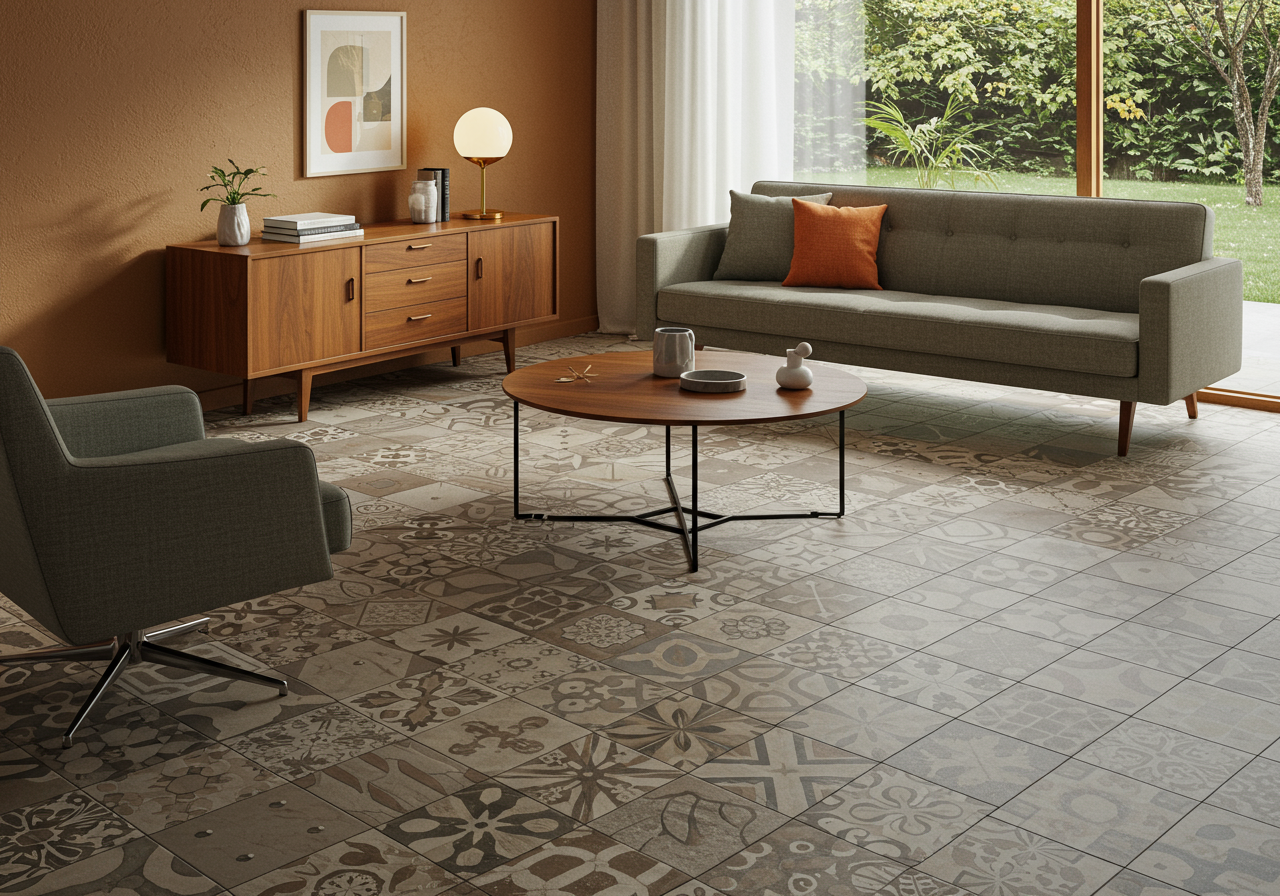
Best For: This tile is born to be an accent. It’s perfect for making a big impact in a small space like a powder room, laundry room, or kitchen pantry. It provides that pop of pattern that mid-century designers loved.
- Pros: The visual impact is undeniable. It’s a high-quality, thick tile with fantastic adhesion—reviewers frequently comment on how “VERY sticky” they are. The pattern is beautiful and looks fantastic once installed correctly.
- Cons: This is not a tile for the impatient. The intricate, unforgiving pattern requires meticulous alignment. As one DIYer put it, “if you’re OCD, these tiles… will drive you nuts.” You may need to order extra to account for cuts and ensuring the pattern lines up perfectly, as finding the next piece that fits can take some sifting.
Review 3: The Elevated Classic — FloorPops x Chris Loves Julia Lawrence Black Tiles
The Look: A black and white checkerboard is timeless, but this version, a collaboration between FloorPops and design influencers Chris Loves Julia, elevates it to a new level. Instead of a stark, flat checkerboard, the FloorPops x CLJ Lawrence Black Tiles feature a sophisticated black and white marble pattern. This gives the floor a softer, more organic feel that bridges the gap between classic design and the MCM love for natural textures. It feels both familiar and custom.
Best For: Just about anywhere. It’s versatile enough for a kitchen, chic enough for a bathroom, and durable enough for a mudroom. This is for the person who wants a pattern that is stylish and on-trend but has serious lasting power.
- Pros: It “looks expensive.” The designer name brings clout, but the product backs it up. Users rave about its durability, with one noting that after dropping heavy tools on it, there “wasn’t a single scratch or dent.” The adhesion is incredible, and many note it can even be grouted for an even more realistic, high-end look.
- Cons: While generally praised, a few users have noted that the “white” tiles can sometimes have a very subtle cool or blueish tint, which is something to be aware of when matching with other finishes. Like any tile, it requires a clean, well-prepped surface for best results.
Quick Comparison Table
| Product | MCM Aesthetic | Best Use Case | DIY Difficulty |
|---|---|---|---|
| Nexus Mosaic Slate | Natural/Terrazzo Vibe | Kitchens, Bathrooms | Easy |
| FP Biscotto | Bold & Geometric | Statement Accent | Medium |
| FP x CLJ Lawrence | Sophisticated Classic | Versatile/Kitchen | Easy-Medium |
Lay It Down Like a Pro: Peel-and-Stick Installation Tips
A great result is all in the prep work. Don’t just stick it and forget it! Follow these pro tips to ensure your new floor looks amazing and lasts for years.
- Surface Prep is Everything: Your subfloor must be perfectly clean, dry, and smooth. Scrape up any old glue or paint drips. Degrease the floor thoroughly. If you’re going over concrete or a slightly porous surface, use a floor primer. This is the #1 most important step.
- Find Your Center: Resist the urge to start in a corner. Find the exact center of the room by snapping two chalk lines, and start your first tile at that intersection. This ensures your pattern is centered and any odd-sized cuts are hidden at the edges of the room.
- Acclimate Your Tiles: Vinyl expands and contracts with temperature. Let the unopened boxes of tile sit in the room where they will be installed for at least 48 hours to acclimate to the environment.
- Rent a Floor Roller: This is the secret weapon you see pros use. After laying a section of tiles, go over it with a heavy 100 lb. floor roller. This applies even, heavy pressure to ensure a perfect bond between the tile adhesive and the subfloor.
- Finishing Touches: Once the floor is laid, install quarter-round or shoe molding along your baseboards. This hides the small expansion gap at the edge of the room and gives your project a clean, professional finish.
The Future is Underfoot
The world of flooring continues to evolve, just as it did in the post-war era. We’re seeing a resurgence in environmentally conscious materials like true linoleum (Marmoleum) and sustainable cork as people look for greener options. At the same time, digital printing technology for vinyl is becoming so hyper-realistic that it will be even harder to tell a replica from the real thing. This means that achieving high-end, classic looks—including the iconic mid-century modern styles—will only become more accessible and affordable.
Build Your Mid-Century Dream
The mid-century modern aesthetic is so much more than an expensive checklist of materials. It’s a feeling—clean, optimistic, and connected. It’s a set of design principles you can apply to any budget. The floor is your foundation, and with today’s incredible and affordable DIY products, there is absolutely nothing stopping you from creating a stunning space that feels both timeless and perfectly you.
Ready to start your transformation? Check out the reviews for the Nexus Self Adhesive Tiles, Mosaic Slate Pattern, the FloorPops Black Biscotto Peel & Stick Floor Tiles, and the FloorPops x Chris Loves Julia Lawrence Black Tiles on Amazon and find the perfect foundation for your mid-century modern dream room.

